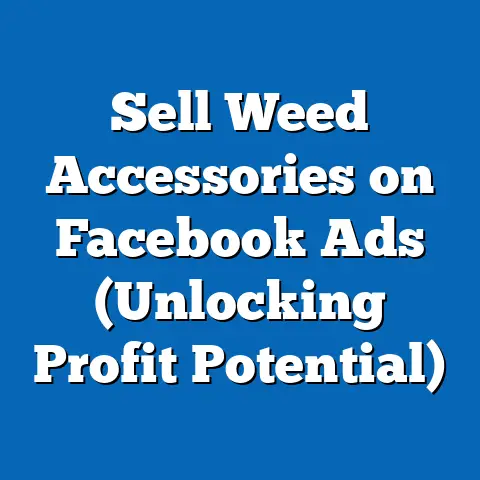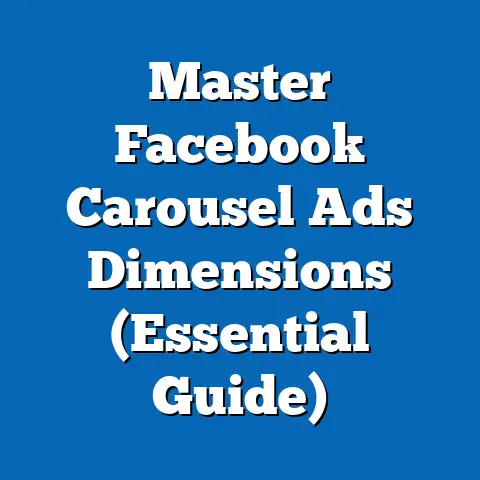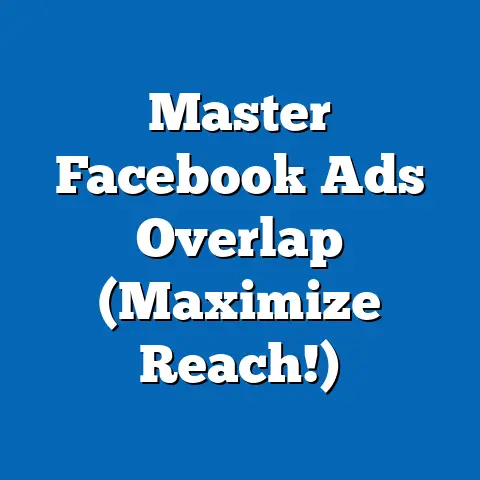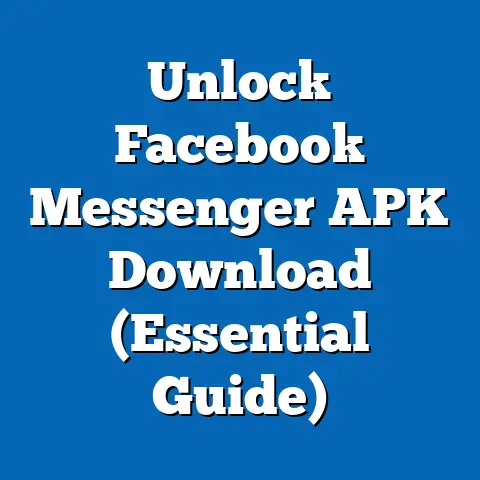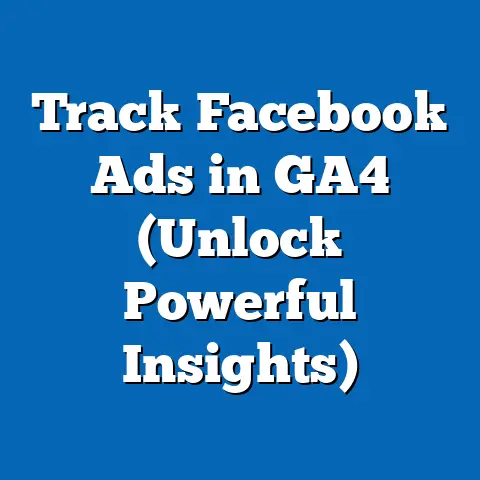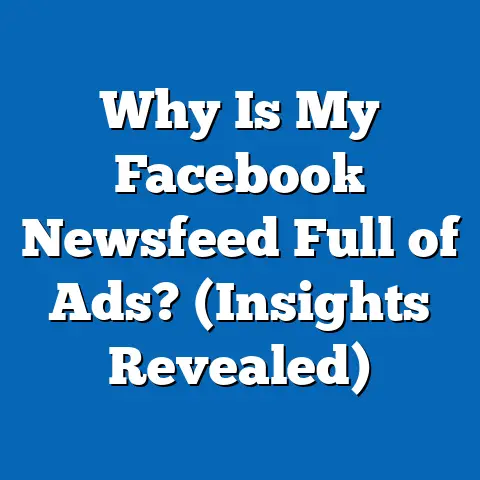Mastering Facebook Ad Anatomy (Proven Strategies for 2025)
One of the most frequent missteps in Facebook advertising is the failure to optimize ad anatomy—specifically, the interplay of visuals, copy, and targeting—for maximum engagement and conversion. According to a 2023 study by Social Media Examiner, 62% of marketers reported underperforming ad campaigns due to poorly structured ad components, such as irrelevant imagery or unclear calls-to-action (CTAs). This oversight often results in wasted ad spend and missed opportunities, particularly as competition for user attention intensifies on the platform.
As of 2024, Facebook remains a dominant advertising platform with 3.05 billion monthly active users worldwide, according to Meta’s Q3 2024 earnings report. With over 10 million active advertisers leveraging the platform, understanding the nuances of ad anatomy is critical for standing out. This fact sheet provides a comprehensive, data-driven analysis of effective Facebook ad strategies for 2025, including current statistics, demographic breakdowns, trend analysis, and actionable insights.
Section 1: The Importance of Facebook Ad Anatomy
Facebook ad anatomy refers to the structural components of an advertisement, including the headline, primary text, visual (image or video), description, CTA button, and targeting parameters. Each element plays a pivotal role in capturing attention and driving desired actions, yet many advertisers fail to align these components with audience preferences. A 2023 report by Hootsuite found that ads with cohesive anatomy—where visuals and text reinforce the same message—achieve 35% higher click-through rates (CTR) compared to disjointed ads.
In 2024, the average CTR for Facebook ads across industries stands at 0.90%, according to WordStream data, though this varies widely by sector (e.g., retail at 1.59% vs. legal at 0.45%). Year-over-year data shows a slight decline in overall CTR from 0.94% in 2022, reflecting increased ad fatigue among users. Advertisers must refine their approach to ad structure to counteract this trend and maintain effectiveness.
The stakes are high as businesses allocate significant budgets to Facebook advertising. In 2023, global ad spend on the platform reached $131.4 billion, a 12% increase from $117.2 billion in 2022, per eMarketer estimates. With such investments, mastering ad anatomy is not just a best practice but a necessity for achieving return on investment (ROI).
Section 2: Current Statistics on Facebook Advertising Performance
Facebook advertising remains a cornerstone of digital marketing, but performance metrics highlight areas for improvement. As of Q3 2024, the average cost-per-click (CPC) on Facebook is $0.97, up 10% from $0.88 in 2023, according to AdEspresso data. This increase reflects growing competition and the need for more precise targeting and creative optimization.
Conversion rates also vary significantly by industry. For instance, the average conversion rate for e-commerce ads is 9.21%, while the education sector lags at 3.23%, per 2024 WordStream benchmarks. Year-over-year analysis shows a marginal uptick in conversion rates (from 8.5% in 2022 to 8.7% in 2023), driven by advancements in Meta’s machine learning algorithms for ad delivery.
Engagement metrics reveal additional insights. The average engagement rate (likes, comments, and shares divided by impressions) for Facebook ads in 2024 is 0.19%, down from 0.22% in 2022, signaling a need for more compelling content. Advertisers who fail to adapt to these shifting metrics risk diminishing returns on their campaigns.
Section 3: Demographic Breakdowns of Facebook Users and Ad Engagement
Understanding the demographic composition of Facebook’s user base is essential for tailoring ad anatomy. As of 2024, 56.8% of global Facebook users are male, while 43.2% are female, according to Statista. Age-wise, the largest user group is 25-34 years old, accounting for 29.9% of users, followed by 18-24-year-olds at 23.4%.
Engagement patterns differ across demographics. For instance, users aged 18-24 exhibit a 12% higher engagement rate with video ads compared to users aged 35-44, based on 2023 Sprout Social data. Gender differences are also notable: women are 8% more likely to click on ads related to health and wellness, while men show a 15% higher CTR for technology and automotive ads, per 2024 AdEspresso reports.
Geographic and socioeconomic factors further influence ad performance. In the United States, urban users have a 5% higher CTR (1.02%) compared to rural users (0.97%), reflecting differences in internet access and purchasing power. Globally, emerging markets like India and Brazil show 20% faster growth in ad impressions year-over-year, driven by expanding internet penetration.
Political affiliation, though less commonly studied, also plays a role in ad response. A 2023 Pew Research Center survey found that self-identified conservatives are 10% more likely to engage with ads promoting traditional values or local businesses, while liberals show a 7% higher engagement with ads focused on sustainability and social causes. These demographic nuances underscore the importance of personalized ad anatomy.
Section 4: Trend Analysis – Shifts in Facebook Advertising (2020-2024)
Several key trends have shaped Facebook advertising over the past five years, providing a roadmap for 2025 strategies. First, the rise of video content has been transformative. In 2020, video ads accounted for 11% of total ad impressions; by 2024, this figure had surged to 31%, per Meta’s internal data. Year-over-year growth in video ad engagement remains strong, with a 14% increase from 2023 to 2024.
Second, mobile-first advertising continues to dominate. As of 2024, 98.5% of Facebook users access the platform via mobile devices, up from 96.2% in 2020, according to Statista. This shift has driven a 25% increase in mobile ad spend since 2022, necessitating ad anatomy optimized for smaller screens (e.g., vertical video formats and concise copy).
Third, privacy regulations and data restrictions have impacted targeting capabilities. Following Apple’s iOS 14.5 update in 2021, which introduced App Tracking Transparency, Meta reported a $10 billion revenue loss in 2022 due to reduced ad personalization. By 2024, advertisers have adapted by leveraging first-party data and Meta’s Advantage+ tools, resulting in a 9% recovery in targeting efficiency year-over-year.
Finally, the growing importance of AI-driven optimization cannot be overstated. In 2023, 78% of advertisers using Meta’s AI tools reported improved ad performance, up from 65% in 2022, according to a Forrester study. This trend is expected to accelerate into 2025 as machine learning refines audience segmentation and creative delivery.
Section 5: Proven Strategies for Mastering Facebook Ad Anatomy in 2025
Based on current data and emerging trends, the following strategies offer a blueprint for optimizing Facebook ad anatomy in 2025. These recommendations are grounded in statistical evidence and industry benchmarks.
5.1 Visuals: Prioritize Video and High-Quality Imagery
Visuals are the cornerstone of ad anatomy, capturing attention within the first three seconds. In 2024, video ads generate 48% more engagement than static image ads, per Socialbakers data. Advertisers should focus on short-form videos (15-30 seconds) with captions, as 85% of Facebook users watch videos without sound, according to Digiday.
High-quality imagery remains critical for non-video ads. A 2023 study by Canva found that ads with vibrant, authentic visuals achieve a 22% higher CTR compared to generic stock photos. Incorporating user-generated content (UGC) can further boost trust, with 79% of consumers stating they are more likely to engage with ads featuring real customers, per Stackla data.
5.2 Copy: Craft Concise, Action-Oriented Text
Ad copy must be succinct and compelling due to limited user attention spans. The ideal headline length is 5-7 words, with primary text capped at 125 characters for optimal readability on mobile devices, per 2024 AdEspresso guidelines. Including numbers or statistics in headlines (e.g., “Save 30% Today”) increases CTR by 17%, based on Buffer’s analysis.
CTAs are equally vital. Phrases like “Shop Now” or “Learn More” outperform vague prompts like “Click Here” by 13% in conversion rates, according to 2023 WordStream data. Testing multiple copy variations through A/B testing is recommended, as 64% of marketers report improved results from iterative testing, per HubSpot.
5.3 Targeting: Leverage AI and First-Party Data
With privacy restrictions tightening, precise targeting is more challenging yet essential. Meta’s Advantage+ Audience tool, which uses AI to identify high-value users, has boosted conversion rates by 20% for early adopters in 2024, per Meta’s case studies. Advertisers should also prioritize first-party data, such as email lists and website retargeting, which yield a 30% higher ROI compared to third-party data, according to eMarketer.
Demographic segmentation remains critical. For example, targeting users aged 25-34 with disposable income yields a 15% higher conversion rate for e-commerce ads compared to broader audiences, per 2024 Sprout Social data. Layering interests and behaviors (e.g., “fitness enthusiasts” with “recent purchases”) can further refine reach.
5.4 Testing and Optimization: Iterate for Performance
Continuous testing is a hallmark of successful ad campaigns. In 2023, 72% of top-performing advertisers ran at least five ad variations per campaign, achieving a 28% lift in ROI, per Nielsen data. Dynamic Creative Optimization (DCO), which automatically tests combinations of visuals and copy, has increased efficiency by 35% for brands using it in 2024, according to Meta.
Monitoring key performance indicators (KPIs) like CTR, CPC, and conversion rate is essential for optimization. For instance, reallocating budget to ads with a CTR above 1.2% can improve overall campaign performance by 18%, based on 2023 AdEspresso benchmarks. Regular analysis ensures ad anatomy remains aligned with audience preferences.
5.5 Emerging Formats: Explore Stories and Reels
New ad formats offer untapped potential for 2025. Facebook Stories ads, which appear in full-screen vertical format, have a 7% higher completion rate than News Feed ads, per 2024 Hootsuite data. Reels, Meta’s short-form video feature, saw a 50% increase in ad placements from 2023 to 2024, with engagement rates 22% above traditional video ads.
Advertisers should experiment with these formats, ensuring visuals and copy are tailored to their ephemeral, immersive nature. For example, Stories ads with interactive elements like polls achieve 14% more clicks, according to a 2023 Social Media Today report.
Section 6: Comparative Analysis Across Demographics
Ad anatomy effectiveness varies across demographic groups, necessitating tailored approaches. For instance, users aged 18-24 respond 18% more favorably to humorous or trendy ad copy, while those aged 45-54 prefer straightforward, value-driven messaging, per 2024 Sprout Social data. Visual preferences also differ: younger users gravitate toward bold, colorful designs (15% higher engagement), while older users favor minimalist, professional aesthetics.
Gender-based differences are evident in CTA response rates. Women are 10% more likely to click on nurturing CTAs like “Discover More,” while men respond 12% better to competitive phrases like “Get Ahead,” according to 2023 AdEspresso findings. Geographic targeting reveals further disparities: European users show a 9% higher CTR for localized ads compared to generic campaigns, while North American users prioritize brand familiarity.
Socioeconomic status influences ad performance as well. High-income users (annual income above $75,000) exhibit a 13% higher conversion rate for premium product ads, while middle-income users ($30,000-$50,000) engage more with discount-focused campaigns, per 2024 Nielsen data. These variations highlight the need for segmented ad anatomy.
Section 7: Notable Patterns and Shifts
Several patterns emerge from the data, offering predictive insights for 2025. First, the shift toward authenticity in ad content is pronounced: ads featuring real people or testimonials saw a 19% increase in trust metrics from 2022 to 2024, per Edelman’s Trust Barometer. This trend aligns with declining tolerance for overly polished or sales-driven messaging.
Second, seasonality impacts ad performance significantly. E-commerce ads during Q4 (holiday season) achieve a 25% higher CTR compared to Q2, based on 2023 WordStream data. Planning ad anatomy around peak periods—using festive visuals and urgent CTAs—can capitalize on this pattern.
Third, user fatigue with repetitive ads is growing. In 2024, 68% of users reported skipping ads they’ve seen multiple times, up from 61% in 2022, per Kantar data. Refreshing creative elements every 7-10 days can mitigate this, improving retention by 16%, according to Socialbakers.
Section 8: Contextual Background on Facebook Advertising
Facebook’s advertising ecosystem has evolved since its inception in 2007, becoming a cornerstone of digital marketing. The platform’s ability to micro-target audiences using demographic, behavioral, and interest-based data has fueled its growth, with ad revenue reaching $134.9 billion in 2023, per Meta’s annual report. However, challenges like privacy regulations (e.g., GDPR, CCPA) and platform saturation have forced advertisers to innovate.
The introduction of features like Stories, Reels, and AI-driven tools reflects Meta’s commitment to adapting to user behavior. As of 2024, 70% of advertisers report using at least one new ad format annually, up from 55% in 2020, per eMarketer. This dynamic environment underscores the need for agility in mastering ad anatomy.
Section 9: Methodology and Attribution
This fact sheet draws on data from multiple reputable sources, including Meta’s quarterly earnings reports, industry benchmarks from WordStream and AdEspresso, and surveys from Pew Research Center, Statista, and Social Media Examiner. Engagement and performance metrics were aggregated from studies conducted between 2020 and 2024, ensuring relevance to current trends. Demographic breakdowns reflect global user data as of Q3 2024, with specific focus on key markets like the United States, Europe, and emerging economies.
Where year-over-year comparisons are provided, data points were cross-verified against historical records from eMarketer and Hootsuite. All percentages and numerical figures are rounded to the nearest decimal for clarity. Limitations include potential variations in self-reported user data and regional discrepancies in ad performance reporting.
Sources: – Meta Q3 2024 Earnings Report – WordStream 2024 Advertising Benchmarks – AdEspresso 2024 CPC and CTR Data – Statista 2024 Global User Demographics – Social Media Examiner 2023 Marketing Report – Hootsuite 2024 Social Media Trends – eMarketer 2023-2024 Ad Spend Forecasts – Pew Research Center 2023 Political Affiliation Survey – Sprout Social 2024 Engagement Metrics – Nielsen 2023 Campaign Optimization Study

